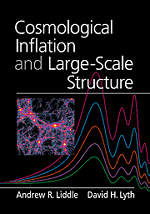Book contents
- Frontmatter
- Contents
- Frequently used symbols
- Preface
- 1 INTRODUCTION
- 2 THE HOT BIG BANG COSMOLOGY
- 3 INFLATION
- 4 SIMPLEST MODEL FOR THE ORIGIN OF STRUCTURE I
- 5 SIMPLEST MODEL FOR THE ORIGIN OF STRUCTURE II
- 6 EXTENSIONS TO THE SIMPLEST MODEL
- 7 SCALAR FIELDS AND THE VACUUM FLUCTUATION
- 8 BUILDING AND TESTING MODELS OF INFLATION
- 9 THE COSMIC MICROWAVE BACKGROUND
- 10 GALAXY MOTIONS AND CLUSTERING
- 11 THE QUASI-LINEAR REGIME
- 12 PUTTING OBSERVATIONS TOGETHER
- 13 OUTLOOK FOR THE FUTURE
- 14 ADVANCED TOPIC: COSMOLOGICAL PERTURBATION THEORY
- 15 ADVANCED TOPIC: DIFFUSION AND FREESTREAMING
- Appendix: Constants and parameters
- Numerical solutions and hints for selected examples
- References
- Index
11 - THE QUASI-LINEAR REGIME
Published online by Cambridge University Press: 05 June 2012
- Frontmatter
- Contents
- Frequently used symbols
- Preface
- 1 INTRODUCTION
- 2 THE HOT BIG BANG COSMOLOGY
- 3 INFLATION
- 4 SIMPLEST MODEL FOR THE ORIGIN OF STRUCTURE I
- 5 SIMPLEST MODEL FOR THE ORIGIN OF STRUCTURE II
- 6 EXTENSIONS TO THE SIMPLEST MODEL
- 7 SCALAR FIELDS AND THE VACUUM FLUCTUATION
- 8 BUILDING AND TESTING MODELS OF INFLATION
- 9 THE COSMIC MICROWAVE BACKGROUND
- 10 GALAXY MOTIONS AND CLUSTERING
- 11 THE QUASI-LINEAR REGIME
- 12 PUTTING OBSERVATIONS TOGETHER
- 13 OUTLOOK FOR THE FUTURE
- 14 ADVANCED TOPIC: COSMOLOGICAL PERTURBATION THEORY
- 15 ADVANCED TOPIC: DIFFUSION AND FREESTREAMING
- Appendix: Constants and parameters
- Numerical solutions and hints for selected examples
- References
- Index
Summary
Gravitational collapse
Overview
The bulk of this book has concerned the linear regime, and it is fair to say that, ultimately, our main understanding of the parameters describing the Universe as a whole will come via observations of that sort, especially those of microwave background anisotropies. However, we would not exist were it not for structures having entered the nonlinear regime, ultimately collapsing to form gravitationally bound objects, and so, it is interesting to ask about this regime. In fact, at present, one of the most powerful constraints on the spectrum comes from this regime, being the present abundance of galaxy clusters.
The nonlinear regime has been investigated using a variety of techniques. The most popular of all is numerical simulations, particularly simulations of the gravitational force alone, known as N-body simulations, though recently many codes have been developed that also include a range of hydrodynamical gas processes and sometimes even radiative processes such as photoionization. We discuss some of these in this chapter, but not in any depth because this is primarily a book about analytical and semianalytical techniques.
Among this latter class are theories designed to predict the number of collapsed objects of a given mass. We discuss two such theories: the Press–Schechter (1974) theory and the theory of peaks (Bardeen et al. 1986). These are semianalytic (meaning that there usually exist integrals that must be performed numerically to deal with realistic spectra, but that the basic structure of the theory is analytic), though it is fair to say that they are only used with confidence because they have been compared and calibrated using N-body simulations.
- Type
- Chapter
- Information
- Cosmological Inflation and Large-Scale Structure , pp. 277 - 300Publisher: Cambridge University PressPrint publication year: 2000
- 2
- Cited by



